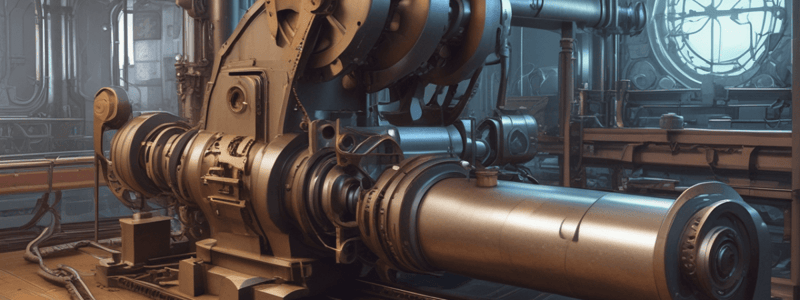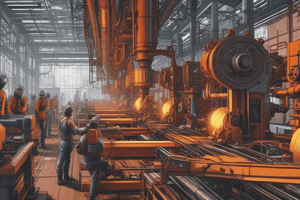Podcast
Questions and Answers
What is the primary purpose of machining in metalworking processes?
What is the primary purpose of machining in metalworking processes?
- To create irregular surfaces on workpieces
- To shape metal components without removing excess material
- To produce components with the desired dimensions and surface finish (correct)
- To increase the hardness of the metal components
Which category of metalworking processes involves turning and milling?
Which category of metalworking processes involves turning and milling?
- Chip forming processes (correct)
- Non-cutting shaping processes
- Forging and pressing
- Grinding and rolling
What is the essential role of cutting tools in machining?
What is the essential role of cutting tools in machining?
- Moving chips away from the work surface
- Reducing friction between the tool and workpiece
- Holding the workpiece in place during cutting
- Removing excess material by gradual cutting action (correct)
Why do engineering components like gears and bearings require machining?
Why do engineering components like gears and bearings require machining?
What distinguishes machining from preforming processes like casting or forging?
What distinguishes machining from preforming processes like casting or forging?
In metalworking, what type of components usually require semi-finishing and finishing after preforming?
In metalworking, what type of components usually require semi-finishing and finishing after preforming?
What is the main role of rake angle in cutting tools?
What is the main role of rake angle in cutting tools?
Which type of cutting tool has more than two major cutting edges involved?
Which type of cutting tool has more than two major cutting edges involved?
In the Machine Reference System, what does ASA stand for?
In the Machine Reference System, what does ASA stand for?
What is the purpose of clearance angle in cutting tools?
What is the purpose of clearance angle in cutting tools?
Which system of description of tool geometry identifies only the salient features of the cutting tool point without providing quantitative information?
Which system of description of tool geometry identifies only the salient features of the cutting tool point without providing quantitative information?
What determines the choice of planes and axes used for expressing tool geometry in the ASA system?
What determines the choice of planes and axes used for expressing tool geometry in the ASA system?
Why is clearance angle a must for cutting tools according to the text?
Why is clearance angle a must for cutting tools according to the text?
What is primarily referred to as tool geometry in cutting tools?
What is primarily referred to as tool geometry in cutting tools?
'Two-point' cutting tools are exemplified by which type according to the text?
'Two-point' cutting tools are exemplified by which type according to the text?
What is the purpose of a machine tool in machining?
What is the purpose of a machine tool in machining?
How does cutting fluid assist in the machining process?
How does cutting fluid assist in the machining process?
Which type of machine tool is suitable for mass production?
Which type of machine tool is suitable for mass production?
What is the basic function of a machine tool in machining?
What is the basic function of a machine tool in machining?
Which classification of machine tools is based on the number of spindles?
Which classification of machine tools is based on the number of spindles?
Which type of machine tool is characterized by housing type blanks?
Which type of machine tool is characterized by housing type blanks?
In machining, what do machine tools do physically?
In machining, what do machine tools do physically?
What aspect is used for specifying a centre lathe?
What aspect is used for specifying a centre lathe?
Which condition favors the formation of continuous chips without BUE chips?
Which condition favors the formation of continuous chips without BUE chips?
What type of chips are formed when cutting brittle materials like cast iron?
What type of chips are formed when cutting brittle materials like cast iron?
Which scenario is associated with higher power consumption?
Which scenario is associated with higher power consumption?
What is the role of a positive and large rake angle in chip formation?
What is the role of a positive and large rake angle in chip formation?
When is shearing of metal observed during the machining process?
When is shearing of metal observed during the machining process?
What is the primary function of cutting fluid in machining processes?
What is the primary function of cutting fluid in machining processes?
What is the angle of chip flow deviation from the orthogonal plane in oblique cutting?
What is the angle of chip flow deviation from the orthogonal plane in oblique cutting?
In pure orthogonal cutting, what is the angle between the chip flow and the reference plane?
In pure orthogonal cutting, what is the angle between the chip flow and the reference plane?
What is the main purpose of machining according to the text?
What is the main purpose of machining according to the text?
What is the major index that the form of machined chips indicates?
What is the major index that the form of machined chips indicates?
What mainly influences the form of machined chips?
What mainly influences the form of machined chips?
What happens when the shear stress in the work material exceeds its shear strength?
What happens when the shear stress in the work material exceeds its shear strength?
In what direction does shear stress develop in the region ahead of the cutting tool during continuous machining?
In what direction does shear stress develop in the region ahead of the cutting tool during continuous machining?
What causes the formation and removal of chips in thin layers during machining?
What causes the formation and removal of chips in thin layers during machining?
How does the lower surface of actual machining chips appear?
How does the lower surface of actual machining chips appear?
According to Piispannen's explanation using a card analogy, what does the phenomenon shown in Fig. 1.11 (b) represent?
According to Piispannen's explanation using a card analogy, what does the phenomenon shown in Fig. 1.11 (b) represent?
What is the definition of the shank of a single point tool in the ASA system?
What is the definition of the shank of a single point tool in the ASA system?
Which angle in the ASA system represents the angle of inclination of the principal flank from the machined surface and is measured on the machine longitudinal plane?
Which angle in the ASA system represents the angle of inclination of the principal flank from the machined surface and is measured on the machine longitudinal plane?
In the ASA system, what does the nose radius of a single point tool provide?
In the ASA system, what does the nose radius of a single point tool provide?
Which type of metal cutting process involves the cutting edge or face of the tool being inclined at an angle less than 90 degrees to the line of action?
Which type of metal cutting process involves the cutting edge or face of the tool being inclined at an angle less than 90 degrees to the line of action?
What makes the analysis simpler in orthogonal cutting process?
What makes the analysis simpler in orthogonal cutting process?
What does the x angle represent in ASA system's tool geometry designation?
What does the x angle represent in ASA system's tool geometry designation?
In ASA system, what does ay represent in tool geometry designation?
In ASA system, what does ay represent in tool geometry designation?
What are the factors that the pattern and extent of total deformation of the chips depends upon in machining?
What are the factors that the pattern and extent of total deformation of the chips depends upon in machining?
In the context of chip formation, which experimental method involves studying running chips using a high-speed camera with a low magnification microscope?
In the context of chip formation, which experimental method involves studying running chips using a high-speed camera with a low magnification microscope?
In machining, what prevents the propagation of a crack at the tool tip in ductile materials?
In machining, what prevents the propagation of a crack at the tool tip in ductile materials?
Which type of materials generally undergo yielding rather than brittle fracture during machining?
Which type of materials generally undergo yielding rather than brittle fracture during machining?
What is the main reason behind why chip thickness (a2) becomes larger than uncut chip thickness (a1) during machining?
What is the main reason behind why chip thickness (a2) becomes larger than uncut chip thickness (a1) during machining?
What are the main mechanisms involved in chip formation when machining brittle materials?
What are the main mechanisms involved in chip formation when machining brittle materials?
What type of chips are generally produced when machining ductile materials?
What type of chips are generally produced when machining ductile materials?
What is the major factor that determines the pattern and degree of deformation during chip formation in machining processes?
What is the major factor that determines the pattern and degree of deformation during chip formation in machining processes?
Which experimental method involves studying deformation of rectangular or circular grids marked on the side surface?
Which experimental method involves studying deformation of rectangular or circular grids marked on the side surface?
What is the possible reason for chip thickness (a2) exceeding uncut chip thickness (a1) during machining?
What is the possible reason for chip thickness (a2) exceeding uncut chip thickness (a1) during machining?
How is chip thickening commonly expressed?
How is chip thickening commonly expressed?
What does a larger value of rc indicate?
What does a larger value of rc indicate?
How is chip thickening also expressed?
How is chip thickening also expressed?
How can the value of rc be reduced according to the text?
How can the value of rc be reduced according to the text?
What does equation 1.5 in the text represent?
What does equation 1.5 in the text represent?
What does shear angle depend on?
What does shear angle depend on?
How does shear angle change with the increase in chip reduction coefficient?
How does shear angle change with the increase in chip reduction coefficient?
What is cutting strain defined as in the text?
What is cutting strain defined as in the text?
'Total volume of chip produced in a given time' conservation is represented by which equation in the text?
'Total volume of chip produced in a given time' conservation is represented by which equation in the text?
What is the formula for cutting strain (average) as mentioned in the text?
What is the formula for cutting strain (average) as mentioned in the text?
What factor(s) can encourage and accelerate the bonding of Built-up-Edges (BUE) as discussed in the text?
What factor(s) can encourage and accelerate the bonding of Built-up-Edges (BUE) as discussed in the text?
In machining soft and ductile metals with tools like high speed steel, where can Built-up-Edges (BUE) grow larger and overflow towards as per the text?
In machining soft and ductile metals with tools like high speed steel, where can Built-up-Edges (BUE) grow larger and overflow towards as per the text?
Under what condition may Built-up-Edges (BUE) be squashed out by the flowing chip according to the text?
Under what condition may Built-up-Edges (BUE) be squashed out by the flowing chip according to the text?
What harmful effect can Built-up-Edges (BUE) formation have on surface finish according to the content?
What harmful effect can Built-up-Edges (BUE) formation have on surface finish according to the content?
What effect does repeated formation and dislodgement of Built-up-Edges (BUE) have on cutting forces according to the text?
What effect does repeated formation and dislodgement of Built-up-Edges (BUE) have on cutting forces according to the text?
Which factor influences the type of chips produced by machining as mentioned in the text?
Which factor influences the type of chips produced by machining as mentioned in the text?






